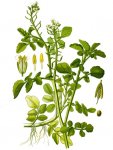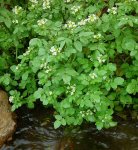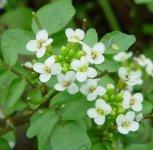Zheruha pharmacy - nasturtium officinale r. Br.
Family Cruciferae - Brassicaceae (Cruciferae)
Botanical characteristics. Perennial herbaceous plant. Stems recumbent or raised 30-90 cm long, often form dense sod. Leaves are fleshy, juicy, dark green; Lower - triple, upper 5-9-lobed. The flowers are white with yellow pronounced anthers, collected in umbellate inflorescences. Blooms from April to June. Fruits until September.
Spread. It grows on moist soils, on marshes, at springs, less often on stony and crushed stone soils, occurs on the plains and foothills, at springs.
Used parts of the plant. Medicinal raw materials are roots, leaves, flowers, fruits. Flowers and leaves are collected mainly during flowering, from them the juice is obtained, which is harvested for future use. After drying, the healing properties of leaves and flowers disappear. Leaves can be collected after flowering, but they have weaker healing properties.
The roots are harvested in autumn until the leaves wilt, dried in dryers at a temperature of 40-45 ° C. However, it is better to make the infusion from the roots immediately after collecting the raw materials. Seeds are harvested as they mature, which are also used fresh or in tinctures.
Chemical composition. The plant has in its composition saponins, alkaloids, mustard oil, thioglycosides: glucanasturcin, glucorassicin and other glycosides containing sulfur. Seeds contain fatty oil, in its composition acids: oleic, linoleic, linolenic, eicosenic, palmitic, stearic, etc .; A large set of microelements: K, I, Fe and others in smaller quantities; Vitamins, mainly A, C, D and others in small amounts.
Application. Roots are official raw materials in France, Italy, Brazil, Venezuela, Switzerland.
Roots and fresh juice of plants are used in homeopathy, with metabolic disorders, decreased liver, gallbladder and kidney function; With anemia, pyelonephritis; Antiscorbutic, with diseases of rheumatoid nature, gout.
In folk medicine of many countries, decoctions of roots, infusion of fresh plants and juice are widely used for cholelithiasis, diseases of the bladder, scurvy, ascites, gout, chronic catarrh of the upper respiratory tract, thyroid diseases, diabetes, oncological diseases, colitis, tumors; Externally - with lipomas, warts; Seeds - as a seasoning for dishes.
Preparation
- For broth take 20 g of fresh leaves and flowers, pour 250 ml of boiling water, insist on a boiling water bath for 30 minutes, cool 10 minutes, without removing from the bath, filter. Take should be 2 tbsp. Spoon 3 times a day after meals.
- Tincture of fresh roots is prepared on 70% alcohol at a rate of 1: 5. Insist 15 days. Take 30-40 drops per meal for 50 ml of water. Gradually, you can increase the dose to 40-60 drops.
- Fresh juice takes 30-60 drops per reception 3-4 times a day for 30 ml of water, after meals.
To enhance the effect is often used together with dandelion and nettles (salad and broth) - in equal quantities.
Contraindications. In large doses and when ingested before meals, the drugs irritate the mucous membranes. In this regard, do not exceed the dose, drink only with water.





Comments
When commenting on, remember that the content and tone of your message can hurt the feelings of real people, show respect and tolerance to your interlocutors even if you do not share their opinion, your behavior in the conditions of freedom of expression and anonymity provided by the Internet, changes Not only virtual, but also the real world. All comments are hidden from the index, spam is controlled.